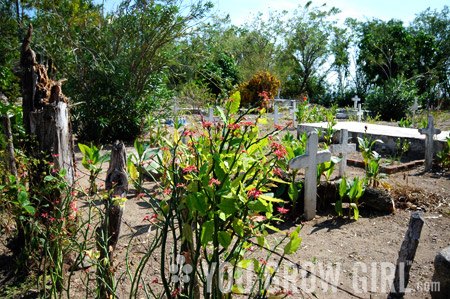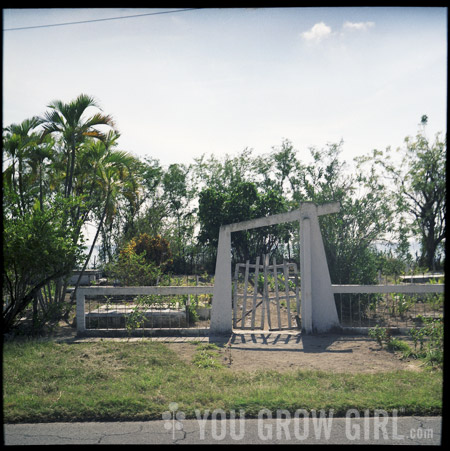
While in the Cuban countryside, we came upon a number of very old cemeteries that always sat right next to the ocean. I was told that one cemetery dated back to 1919. How they managed to survive the hurricanes when so many homes with much more distance from the ocean haven’t is beyond me.
This particular type of euphorbia seemed to skirt the edges of all but one of them. That one was fenced by a much tougher euphorbia. This plant looks very similar to Poinsettia (Euphorbia pulcherrima) and I’ve been struggling to decide if it is or isn’t since our trip. Here’s a closer shot.
My argument FOR identifying it as Poinsettia are:
- It gets very scraggly and vine-like when growing in tropical countries. Nothing like the potted plants North Americans display and then subsequently toss every holiday season.
- Let’s compare. Here’s a picture I took in Mexico years ago. This particular plant was growing in the tended garden of someone’s backyard. Plants were being watered with hoses through the duration of our stay. So the difference here is a tended plant versus a plant that is left to fend for itself.
- It was the dry season, which would account for extra straggliness.
- It was growing in sand literally just off the beach. The beach was right on the other side of the cemetery. There were some trees providing a bit of shade but many plants were fully exposed. Let me tell you, it was HOT and the sun was punishing. That’s a lot for a poinsettia to take. They prefer a bit of shade coverage.
- Look at the leaves and the little red bracts. They look right, albeit on the small side. But numbers 2, 3, and 4 could account for that.

My argument AGAINST identifying it as Poinsettia are:
- I find it shocking to believe that poinsettia could survive that degree of extreme heat, sun and drought. See #4 (above).
- There are gazillions of euphorbias in the world. I’ll admit my experience of them barely begins to cover the myriad of species out there. There is a very good chance that there is a plant very similar to poinsettia.
- I am not an authority on poinsettias. I can barely stand the plant. Although I will say that I much prefer it growing wild and straggly. The cultivated potted varieties do little for me.
What do you think? Yay or nay?

As an aside, here’s another shot of the same cemetery. It was pretty incredible. Sigh. Let’s all get on a plane right now and go to Cuba together. I hear it’s warm there.
I would tend to agree that it is some variety of Poinsettia. It’s growth habit and leaf shape are diagnostic. Also, it’s location in Cuba in proximity to it’s native Mexico, I believe, makes sense. A researcher at school once grew 30 varieties of poinsettia, which all looked different, so there is definitely more variability than what we see in the market.
Would you agree that it was planted?
Oh yes, definitely planted.
It doesn’t look like poinsettia I’ve seen just because the leaves and “flowers” are usually the same shape and size, just different colors. However the climate issue (AGAINST #1) doesn’t concern me at all as I once saw a picture in a magazine of a family posing in front of a poinsettia HEDGE that was at least 10 feet tall and very dense with tons of color
the picture I saw was taken in Mexico, forgot to add that part, so I would guess they’d do fine in Cuba, too
It looks more like a Pedilanthus sp. to me… They still belong to the Euphorbiaceae though. Quite a common houseplant (and sometimes a weed) in Australia.
Lucy: I think you might be right! I have never seen it as a houseplant here in Canada.
Sounds like you may have it. Regardless, it’s an interesting plant. And I second going to Cuba.
It definitely looks like Pedilanthus to me – or Devil’s Backbone is one of the common names used here in Florida. There are some very nice variegated varieties available.
I have no idea about the plant but the picture of the cemetery just made my heart ache with melancholy. It’s been 25 years since I saw a cemetery like that with plants that have survived a lifetime since they were planted to beautify someone’s grave. I hate to get philosophical but it sure makes me wonder about the mood and circumstances of the person who planted the plant in the picture. Alas, those of us in the US are not allowed to go to Cuba. Maybe some day this insanity will end and I will get to visit the island.
David: I’ve been wondering how and when the plants got there myself. See all the cannas in the background? I forgot to mention those.
I will say though that while visiting a different graveyard I was told that a local man cleaned and maintained it all himself as a volunteer effort. That graveyard had a lot of cacti so less gardening maintenance but with the hurricanes I’d bet he had a lot of work to keep up with.
What resources do you use to determine the species of your plants and more importantly how do you figure out what size of a container you’ll need?
I’ve also been wondering about climate, someone told me to figure out what climate my plants came from to better decide where to place them in my yard but how do I find out what kind of climate “Eurasia” has. That’s a pretty general statement, an entire continent which has everything from tundra to desert.
Hi Gayla,
Its definitely a Pedilanthus tithymaloides or Red Slipper Spurge. Its a bit of a weed in South Africa.